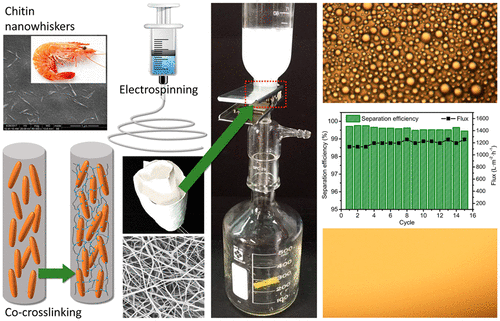当前位置:
X-MOL 学术
›
ACS Sustain. Chem. Eng.
›
论文详情
Our official English website, www.x-mol.net, welcomes your
feedback! (Note: you will need to create a separate account there.)
Reusable and Recyclable Superhydrophilic Electrospun Nanofibrous Membranes with In Situ Co-cross-linked Polymer–Chitin Nanowhisker Network for Robust Oil-in-Water Emulsion Separation
ACS Sustainable Chemistry & Engineering ( IF 7.1 ) Pub Date : 2017-12-29 00:00:00 , DOI: 10.1021/acssuschemeng.7b03102 Jian-Xiang Wu 1 , Jie Zhang 1 , Yan-Li Kang 1 , Gang Wu 1 , Si-Chong Chen 1 , Yu-Zhong Wang 1
ACS Sustainable Chemistry & Engineering ( IF 7.1 ) Pub Date : 2017-12-29 00:00:00 , DOI: 10.1021/acssuschemeng.7b03102 Jian-Xiang Wu 1 , Jie Zhang 1 , Yan-Li Kang 1 , Gang Wu 1 , Si-Chong Chen 1 , Yu-Zhong Wang 1
Affiliation

|
The structural stability and mechanical strength of hydrophilic polymer nanofiber (NF) membranes are relatively low, because of the creep effect of polymer chain when swelling in water for a long time, which lead to a poor reusability in the fields of water treatment. In this work, we demonstrated a facile and green strategy for preparing eco-friendly hydrophilic nanofibrous membranes with excellent reusability and recyclability that could separate oil-in-water emulsion in practical conditions by using bio-based chitin nanowhiskers (ChNWs) as reinforcement and “co-crosslinking hub” for hydrophilic nanofiber matrix. The as-prepared membranes exhibited very good separation performance, with a separation flux of 1100–1300 L m–2 h–1 and a separation efficiency of >99.5%. The reusability and recyclability of the membranes were evaluated and had proved to be robust enough to effectively separate emulsions after recycling at least 5 times. Moreover, the NF membranes were capable of effectively separating oil-in-water emulsions not only for a wide range of pH but also under hypersaline conditions. This work, as well as co-cross-linked strategies, enrich the exploration of superhydrophilic nanofibrous membranes for its significant potential in the field of oil spills and industrial oily wastewater treatments.
中文翻译:

具有原位共交联聚合物-几丁质纳米晶须网络的可重复使用和可回收的超亲水电纺纳米纤维膜,用于稳健的水包油型乳液分离
亲水聚合物纳米纤维(NF)膜的结构稳定性和机械强度相对较低,这是因为聚合物链在水中长时间溶胀时的蠕变效应,导致在水处理领域的可重复使用性较差。在这项工作中,我们展示了一种制备绿色环保亲水性纳米纤维膜的简便且绿色的策略,该膜具有出色的可重复使用性和可回收性,可以通过使用生物基甲壳质纳米晶须(ChNWs)作为增强剂,在实际条件下分离水包油乳液,并“亲水纳米纤维基质的“共交联中心”。所制备的膜表现出非常好的分离性能,分离通量为1100–1300 L m –2 h –1分离效率> 99.5%。对膜的可重复使用性和可回收性进行了评估,并证明其足够坚固,可以在至少回收5次后有效地分离乳液。此外,NF膜不仅可以在很宽的pH范围内而且在高盐度条件下都能有效分离水包油型乳液。这项工作以及共同交联的策略,因其在溢油和工业含油废水处理领域的巨大潜力,丰富了对超亲水性纳米纤维膜的探索。
更新日期:2017-12-29
中文翻译:

具有原位共交联聚合物-几丁质纳米晶须网络的可重复使用和可回收的超亲水电纺纳米纤维膜,用于稳健的水包油型乳液分离
亲水聚合物纳米纤维(NF)膜的结构稳定性和机械强度相对较低,这是因为聚合物链在水中长时间溶胀时的蠕变效应,导致在水处理领域的可重复使用性较差。在这项工作中,我们展示了一种制备绿色环保亲水性纳米纤维膜的简便且绿色的策略,该膜具有出色的可重复使用性和可回收性,可以通过使用生物基甲壳质纳米晶须(ChNWs)作为增强剂,在实际条件下分离水包油乳液,并“亲水纳米纤维基质的“共交联中心”。所制备的膜表现出非常好的分离性能,分离通量为1100–1300 L m –2 h –1分离效率> 99.5%。对膜的可重复使用性和可回收性进行了评估,并证明其足够坚固,可以在至少回收5次后有效地分离乳液。此外,NF膜不仅可以在很宽的pH范围内而且在高盐度条件下都能有效分离水包油型乳液。这项工作以及共同交联的策略,因其在溢油和工业含油废水处理领域的巨大潜力,丰富了对超亲水性纳米纤维膜的探索。


















































 京公网安备 11010802027423号
京公网安备 11010802027423号